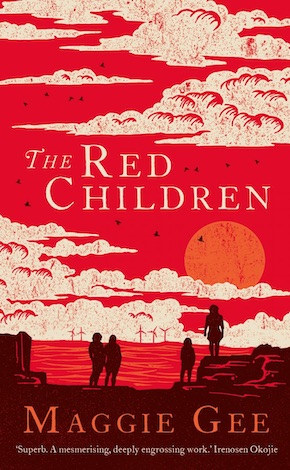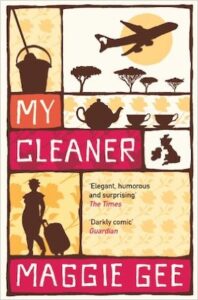Maggie Gee: Being human
by Mark ReynoldsHot on the heels of the release of a 20th anniversary edition of her Orange Prize-shortlisted The White Family, Maggie Gee’s latest novel The Red Children is a sequel of sorts. But the sometimes stark realism of the earlier book, which was motivated by her grief, anger and shame over the murder of Stephen Lawrence, makes way for a playful near-future fable in which a wave of new migrant children in Ramsgate turn out to be exiles from a community of Neanderthals who are escaping their warming homeland. They have survived undiscovered and unscathed in Gibraltar’s Gorham’s Cave Complex – a site now known to have been occupied by Neanderthals and early modern humans over a span of 120,000 years. On a visit to the caves in 2014, Professors Clive and Geraldine Finlayson gave Maggie a tour and showed her the cave carving that has become known as the ‘Neanderthal hashtag’, which appears as a magical symbol throughout her book. The novel also reckons with the recent discovery that Neanderthal DNA exists within all humans, and research that shows Neanderthals were far from the primitive ape-men of common perception. Maggie’s Red Children are joyfully uninhibited, whip-smart but naïve in some respects, but certainly capable of teaching their host community a thing or two about meaningful social interaction. This inventive, heartfelt, eye-opening and wholly believable meditation on our near-future hopes and fears includes a memorable scene in which the Viking longship the Hugin, originally gifted to Ramsgate by Denmark in 1949 to mark the 1500th anniversary of the friendly landing of Anglo-Saxon chieftans in Kent, is patched up and sets sail in the dead of night. The Hugin stands proudly overlooking the sea on the same stretch of coast where Julius Caesar landed in 55BC, which adds another intriguing layer to perceptions of British heritage and identity.
Mark: You say in the author’s note that final form of The Red Children came to you almost as a dream. So what elements were already in place, and how did you go about capturing that dream?
Maggie: I knew I wanted to write about Neanderthals, I knew I wanted to write about climate change, I knew I wanted to somehow move up into the future, but I had originally envisaged a book about Neanderthals in Neanderthal times. It was probably thinking about the idea that we’ve all got Neanderthal genes in us, that Neanderthals have survived in us and that we are them, and I suddenly thought, Why shouldn’t I let Neanderthals survive underground in Gibraltar? And I talked to these two wonderful Neanderthal experts in Gibraltar and they were just incredibly creative and encouraging. So I was going to set it in Gibraltar, but during lockdown when things became impossible, and also as I went through ways I could convey Neanderthal language and deep history, I thought, it’s all got to come together here, where I am. I can’t go anywhere else. And I did sort of dream it, that they arrived here, where we see other migrants coming in – and everybody has all sorts of complex feelings about them – and I just imagined these magical people arriving from the past, who could tell us so much we didn’t know about ourselves, and went on from there. I saw it all happening as I went on walks, I walked along the cliffs and looked at the trees coming into bloom, and just imagined them walking with me. It was a lovely experience writing that dream.

The symbol carved into the wall at Gorham’s Cave. gorhamscave.gi
So how long was the process once you’d got that idea fixed?
Probably two-and-half years, something like that. But the whole process began when I visited the Neanderthal caves. So, like a lot of my books, it was a long germination. I always think writers get too easily discouraged, really.
The Neanderthal survivors are a symbol of the human tendency to ‘other’ outsiders that has rather dominated our history. Why do you suppose that is such a persistent trait, and how do we overcome it?
That’s such a big question – why are we so keen to understand the world as a place where we are the dominant species, and people who look like us are the best? This is a real problem. I’m very interested in evolutionary biology. One of my heroes is W.D. Hamilton, who was a great thinker and a very good writer, and he said two things: first, that the human genetic pool needs to be constantly refreshed by incomers. You need that diversity for genetic health. And the other thing he said was that human beings are wrongly keen to look for threat in others who appear to be genetically different from them. The big problem is that we don’t understand how to know whether or not people are genetically different, because skin colour is a hopeless indicator, it’s only a few genes that code for it. We have to grow up and know more about ourselves and accept that none of us are English, none of us are Welsh, none of us are Scottish, we’re all this incredible mixture. That’s what I tried to celebrate in The Red Children. Just as we are the children, many, many centuries removed, of the Romans who came here as invaders and who we fought off with desperate ferocity, all new migrants will become us, and we have to learn to love them, because we certainly need them.
I just imagined these magical people arriving from the past, who could tell us so much we didn’t know about ourselves… I walked along the cliffs and looked at the trees coming into bloom, and just imagined them walking with me.”
It’s useful to be reminded that human history is also a story of migrations. Especially at a time when the UK government is making such a hash of welcoming Ukrainians fleeing from the war with Russia.
It was quite amusing to watch the government realising that the British population were appalled at how ungenerous they were bring towards the Ukrainians. And then Michael Gove went, “OK then, you host them. Come on, come forward, you can all do it yourselves. We won’t do any of the kind of monitoring we normally do to make sure it’s safe, and we won’t do anything like the funding we would normally have to do, and we won’t work carefully and slowly with all the organisations who know something about it. No, you do it yourself, let’s have DIY migration! Then nobody can look at us and moralise.” I feel suspicious of the motives of the government, moved by the welcome that a lot of people are showing, slightly anxious about those who might be so economically desperate that any kind of funding offered by the government looks like a help. So I’ve got a complex view of it. I think it’s a great idea in theory, but great ideas without proper funding can go very badly wrong.
And the fact that each prospective host has to actively seek out their own refugees is just bizarre.
Pick your own migrant! Oh God, yes. No, it just can’t work like that, or why would adoptions, which are attended with so much care, over such long, arduous years, and with real goodwill on all sides, still break down, still go wrong. But if it means some families come here and are really welcomed by those that can do it, I can’t say it’s not a good thing.
On another big theme, what more should the international community be doing to counter the threats of climate change? Right-wing pundits like Julia Hartley-Brewer seem to think Britain shouldn’t bother mitigating because we’re only responsible for one per cent of emissions…
Oh dear… Yes, well, all households are only responsible for a microscopic amount, but if all households did their bit things might get better. I think the real problem with something like the Russia-Ukraine war is that it detracts from the really important long-term things that will actually determine not just our future but the future of all the other species we must appreciate as other living presences on the planet. We forget the long-term things and suddenly the use of oil becomes a critical concern, and therefore everybody starts back-pedalling on the agreements that were achieved with such difficulty. I do think there’s a problem with us being a short-lived species. We have short lives, and our concentration seems restricted to about five minutes. And when I watch what’s happening in that war, the warming effects of all this weaponry, the destruction of vegetation, all the rebuilding that will be necessary, obviously it’s a human tragedy and a political tragedy, but I see it as a global warming tragedy too. So what do I think the international community can do? I’m not a policy advisor, but as a writer all I can do is try and make the crisis imaginatively real, and do it in a way that makes people feel hopeful, not paralysed with depression. And part of that for me is to say: Look at what’s still here, just look at this glorious, fabulous, wonderful, rich tapestry. What there is on the surface of this planet is amazing: how life has complexified, how consciousness has proliferated, it’s so wonderful. We just have to think about how we want to live.
We know now that Neanderthals’ brains were at least as large as ours, and they probably had a very good grasp of things like mathematics and abstract thought.”
On your visit to Gibraltar with the Finlaysons, you were able to see the ‘Neanderthal hashtag’ up close.
I did, I was so, so lucky. You can only see it by torchlight, and it’s like being in a church, it’s a wonderful thing. I didn’t touch it (I so wanted to). I did feel very lucky, and that also says something about the net of understanding between people of goodwill that is there if you’re ready to welcome. Also deep curiosity, deep listening, that’s what we have to give to each other. Reading is a form of deep listening, isn’t it? Staying with something, and being affected by it.
And just how precipitous is the path down to the sea cave?
Horribly so! The drop’s utterly precipitous, I just had to not look because I’m actually afraid of heights – very afraid – but it was so worth it, to go where they had been. It’s now a World Heritage site, so the aim is to make it open to everybody, but that will require very careful monitoring of how many people go at once, and there’ll also have to be another form of access.
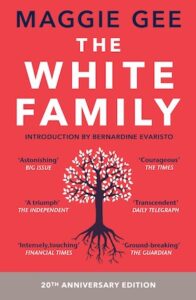
“A powerful and important book that was way ahead of its time.” Bernadine Evaristo
After reading your introduction to the new edition of The White Family, I was expecting to encounter some familiar characters in The Red Children, but of course Winston was unborn at the end of The White Family, and his mum and uncle are on the periphery here.
Yes, he was in the womb, but he appeared meanwhile in The Flood as a child, him and his twin brother. And so he’s grown to be an adult and he’s now the head teacher at the Ramsgate grammar school, where he’s dealing with all sorts of challenges that there’s no precedent for with the arrival of all these migrant children, the refugee children for whom there’s no paperwork and therefore no procedure. And he does what he should do, which is to be open-hearted and say, Let them come in.
And Monica Ludd from your 2019 novel Blood also makes a reappearance. Why was it irresistible to drop her into the school?
Oh, I adore Monica Ludd. She’s the unacted part of me – it’s something Virginia Woolf said, that her characters were her unacted parts. As a sort of slight, polite person, I love inhabiting this loud six-footer who’s got no sense of political correctness and always says the wrong thing – but she usually does the right thing, doesn’t she? She’s the most important single factor in the welcome the Red Children get. What she’s done is she’s used her own status of always having been strange and an outsider, and turned that into an imaginative understanding of the Red Children, who don’t behave like the children of Kent. No one has told them that you don’t fart in lesson, you don’t laugh non-stop, they’re really not very happy if they’re not touching each other, because they’re a very communal species, the way they’ve lived together in caves at close quarters. But the children of Ramsgate learn from them. We know now that Neanderthals’ brains were at least as large as ours, and they probably had a very good grasp of things like mathematics and abstract thought, so in my novel they are astonishingly good at maths, and they do very well on the so-called – and it does exist – Culture-Fair Ability Test. (You’ll probably remember one of the teachers thinks they should take the Not-Fair Ability Test instead, because otherwise it’s not fair!)
In spite of my expectations, The Red Children is probably closer thematically to The Ice People, since both imagine a future world compromised by climate. Do you see those two novels as a kind of pair?
They’re sort of a pair, because they’re both a fable and they both have a sense of irony and lightness and humour, because I’m not constrained by realism. In The White Family I was so involved in the characters, and the characters were so real to me – there are at least thirteen narrators, whereas both The Ice People and The Red Children have a single narrator. I think they’re different though, because The Red Children is late work – I think I must accept I’m not going to live to be 150! – and I think there’s more of a sense of goldenness about it, that I’m wanting to assimilate and make sense of life in a way that is transcendent, and therefore nearer to the comedic than the tragic. I’m wanting to see and hope for a happy ending, something that life often doesn’t give and art can.
 In between you also published My Cleaner and My Driver, which explore similar themes of race, culture, difference and intolerance. But where did Virginia Woolf in Manhattan spring from?
In between you also published My Cleaner and My Driver, which explore similar themes of race, culture, difference and intolerance. But where did Virginia Woolf in Manhattan spring from?
My Cleaner and My Driver were a pair, set in Uganda, and they were inspired by going to Uganda, and a complete opening of a window on a world I knew nothing about, enabled by an Arts Council grant for which I’m still deeply grateful. But then I had to come back, and you have to keep doing something different, and I thought I ought to go back to my literary inspirations from my twenties. I thought about Virginia Woolf because for my generation of women, grounded in the latter half of the twentieth century, her reputation was still rising. We were part of the huge praise that helped her to be what she is now, the preeminent woman writer probably here and in America. You could never ‘own’ a writer but she was my chosen model, although we’re from totally different class backgrounds and totally different privilege. And what I thought was, she’s been so inspirational but her suicide makes her a difficult model for women. We don’t want female creativity linked to self-destruction – although the world has often conspired to make female creatives feel extremely unhappy. And so I brought her back to life in Manhattan, because she’d always wanted to go there, she’d always been fascinated by America. She’d written one essay that was an imaginary visit to America, and I knew about that. So I started rereading all her work, and then I went to New York, to the New York Public Library, and I read this essay in a little private reading room, because the books are not on open shelves, and I thought, If only she had come to life in the reading room, if only she would. And then I thought, Ah! I’ll start this novel with a scholar in the reading room of the New York Public Library, and Virginia Woolf will come back to life. So I let them go off and have a great time in New York. It’s not entirely an easy jaunt of a book, because Virginia Woolf if she came back would have to come to terms with the effect of her suicide on others. And I also wanted to take her back to Turkey, where she really did travel in real life as a young girl, and I revisited those diaries. I let her go to Turkey, and I gave her two Turkish lovers, one male and one female, and I also put in a real-life conference which I attended in Turkey, which in some respects was based upon an international conference – the only one there’s ever been – about my own work, where I was in the audience. So Virginia Woolf is the audience at this Turkish conference, and there was one point in the conference about me where I had to interject, and Virginia Woolf interjects in her conference in that novel. I do see it as a great happiness being a writer, and part of that tradition, and I do want to say hello to both younger writers and older writers and say thank you to them.
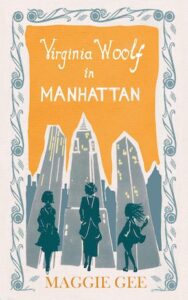 If pushed, which of your novels would you most like to see adapted for TV or film? And which might be the most problematic to see made?
If pushed, which of your novels would you most like to see adapted for TV or film? And which might be the most problematic to see made?
I think they’re all very visual, and I love film. Film has definitely affected lots of my technique. It’s hard to say. At the moment I think The Red Children, because The Red Children is still dancing around in my brain. I actually think Blood is probably the easiest to do, because it’s got a very strong, dramatic storyline (in which the indomitable Monica Ludd goes on the run after the attempted murder of her bullying father, and singlehandedly takes out a terrorist who has infiltrated her previous school). Virginia Woolf in Manhattan for which I was very honoured that Andrew Davies bought the rights and wrote a screenplay, would be very good to do in that Virginia Woolf has already got that cachet. I think that would be enormous fun to do, but you would have to either recreate Istanbul or you’d have to go to both Manhattan and Istanbul. I’ve got as far as thinking about who I would like to play the characters, and I think Meryl Streep would make a wonderful Woolf. She can do anything, can’t she?
The old park keeper has always overtly been racist. Nevertheless, finally, his sense of justice and decency is sufficient to do the right thing. And that to me is really important, it’s saying you can be better than you think you are.”
And if The White Family were to be made, it would give you the chance to expand Elroy’s character…
Yes, there’s a sense in which I’m not really happy with the character of Elroy, insofar as he’s not really shown enough from inside. He’s much more of a character in The Flood, actually. It was 2002 when it came out, it was written in 1995, and there was a lot of fear at that point about writing characters who were not white. At that point, white people were not doing very much writing about racism at all. It caused immense anxiety among publishers, so my anxieties were quite well founded, and I wasn’t quite brave enough. I was quite brave – brave enough for the book to get turned down by all the mainstream publishers! But yes, The White Family is a lovely, big-hearted book, about how what you could call the original home population responds to newcomers, what it does, how it looks at otherness, whether it can only see other or whether it can see itself. And it’s really also about the rule of law. I like law because it’s better than lawlessness. In Uganda there have been some extraordinarily brave lawyers who have been the only thing that has mitigated the political system. And we saw the same thing when Boris Johnson tried to prorogue parliament and Lady Hale and the other Justices said, You can’t do that, it’s against the law. Nevertheless, laws do not work unless there’s pressure from outside. And what finally happened with the Stephen Lawrence case – and it’s the murder of Stephen Lawrence that inspired, though is not the factual basis in any sense of The White Family – was that popular outrage and the civic dutifulness of lawyers and the endless perseverance of Stephen Lawrence’s parents forced the law finally to bring two of the perpetrators to justice. It wasn’t satisfactory, but it was better than nothing. In The White Family the image of that is that the old park keeper Alfred, who has always overtly been racist. Nevertheless, finally, his sense of justice and decency is sufficient, whatever his prejudices, to do the right thing. And that to me is really important, it’s saying you can be better than you think you are, and that it’s not just about who puts the best face on things, who uses the right language. It’s about a lot more than that. It’s about genuinely motivating yourself to do whatever is in your power. And in the end I love Alfred, although I hadn’t liked him all the way through, because ultimately he reclaims his heroism and he does something terrific, which is putting justice before family.
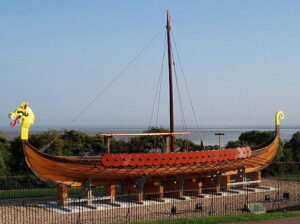
The Hugin at Pegwell Bay, Ramsgate. A replica of the original gifted by the Danes in 1949. Peter Lelliot, geograph.org.uk/Wikimedia Commons
On the subject of crime and justice, now that you’ve revealed how to make the Hugin seaworthy, how would the people of Ramsgate react if it were stolen in a copycat crime?
I love that! Well, this is a very marine and naval community still, and the Sea Cadets have been extremely helpful to me in writing this book, in helping me check things, and they would definitely not allow the stealing of the Hugin. It wouldn’t get a foot off its blocks. Except who knows? If the cause was good enough, who knows who might turn a blind eye?
Finally, what are you writing next?
I’m trying to write about common ground, and the loss of common ground. What I saw happening during lockdown which was, by stealth, the erosion of footpaths. When not enough people were using the land, it seemed to me we were losing more land than ever. It is going to be quite a British book, but I think it’s one that has applications all over the globe, where we do not want the super-rich to take away what is every single living person’s birthright, and every single living being’s birthright – i.e. enough earth and enough nutrition and enough light and air to live.
 Maggie Gee is the author of seventeen critically acclaimed books, which have been translated into more than fifteen languages. A Fellow and Vice-President of the Royal Society of Literature and Professor of Creative Writing at Bath Spa University, she was awarded an OBE in 2012 for her services to literature. The Red Children,The White Family and many of her other books are published by Telegram.
Maggie Gee is the author of seventeen critically acclaimed books, which have been translated into more than fifteen languages. A Fellow and Vice-President of the Royal Society of Literature and Professor of Creative Writing at Bath Spa University, she was awarded an OBE in 2012 for her services to literature. The Red Children,The White Family and many of her other books are published by Telegram.
Read more
@maggiegeewriter
@SaqiBooks
Mark Reynolds is a freelance editor and writer, and a founding editor of Bookanista.
@bookanista
wearebookanista
bookanista.com/author/mark

